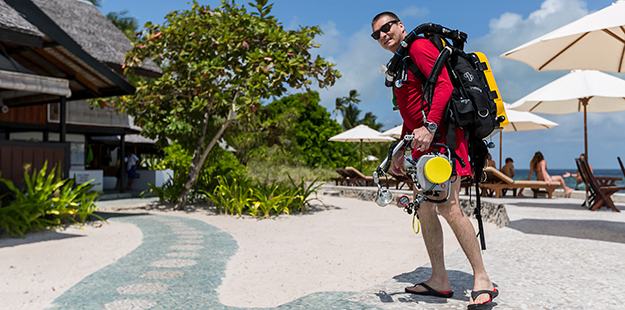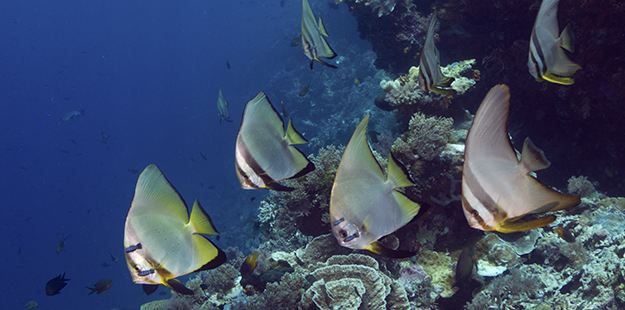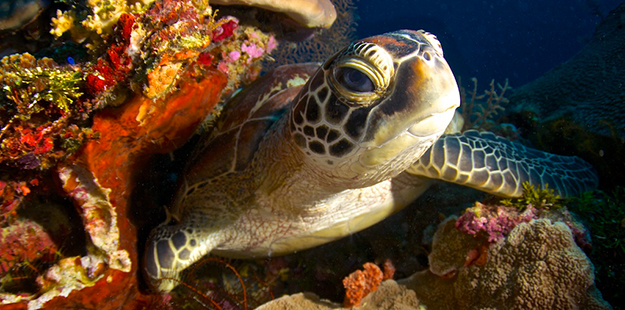Say Bye Bye to Bubbles
Many of Wakatobi’s favorite dive sites are even better when experienced on closed-circuit scuba.
Between scheduled boat dives, taxi boat excursions and unlimited shore access to the House Reef, bottom time is never in short supply at Wakatobi. So why then would you need a closed-circuit scuba system that can further increase your in-water times? Divers who have made the move to closed-circuit scuba, aka “rebreathers,” will point out that there are advantages of these systems beyond increased duration: silent swims, warm/moist breathing gas, constant buoyancy, less dehydration… and the list goes on. Wakatobi was among the first dive resorts in the world to support the use of rebreathers. The dive center stocks the necessary consumables; the staff is versed in the ways of the equipment. Closed circuit divers are welcome on all boat trips, dedicated boats are also made available to rebreather groups, and even extended-range diving is supported. Here are just some of the ways rebreathers can enhance the experience on dive sites at Wakatobi.

At Wakatobi divers have the option to enjoy extended CCR dives mere steps away from the dive center, entering from the beach or off the jetty ladder. Photo by Marco Fierli

Rebreather divers can explore the deeper portions of Wakatobi’s walls and reefs, taking their time as they move up into the shallows. This image was taken at 74 m/230 feet on the site known as Magnifica. Photo by Dr. Claus Meyer
Home field advantages
Diving Wakatobi’s House Reef is about as easy as it gets. Wade in whenever you want, set your own pace, explore the slope or stay shallow and stalk critters in the grass beds. And if you run low on air, a fresh tank is just a short swim away. So why bother with a rebreather, especially if you are diving shallow? Because closed circuit diving can add an even greater range of comfort, convenience and flexibility to the scenario. “I spent one entire week diving solo on the House Reef” says Dr. Claus Meyer. It is so easy to reach at any time of day or night. I set my own schedule, using the taxi boats to reach a desired area, then stayed as long as I wanted. There was always plenty of time to look close and really take in the details.” One of the big attractions at sites such as the House Reef are the small things. And when you are staking out a coral head, waiting patiently for some elusive marine animal to show itself, the lack of bubbles and unchanging buoyancy of a rebreather make it much easier to hover close and in near silence,” he says.
Should you want to venture deeper and explore the lower reaches of the reef, the fixed oxygen partial pressure of a rebreather’s gas mix can provide significantly more bottom time, or a greater safety margin. Drop down and explore the lower slopes of the reef, work your way gradually toward the crest, then finish the afternoon with an extended stay in the shallows. The moist breathing gas a rebreather delivers will reduce dehydration and decrease the cotton mouth effect. And should you happen across that rare and interesting creature, you can stay as long as you like; it may be hunger rather than a declining pressure gauge that eventually ends the dive.

One the greatest advantages CCR divers have is the ability to stay submerged for extended periods of time. This provides more opportunity to linger on walls and canyons at sites like Turkey Beach (part of the house reef), where schools of batfish and snappers are frequent. Photo by Walt Stearns

Being on a closed system can play an important role in just how close and how long a diver can get to more skittish members of the marine community. This green turtle, which was spotted during a drift down the house reef wall, seems to prefer the silent, no bubbles approach. Photo by Steve Miller
All-day drifts
With a continuous reef running for miles on either side of the resort, divers at Wakatobi have a unique opportunity to perform drift dives that carry them right back to the dive center. When the current is flowing from the east, the place to start is Turkey Beach. One of the resort’s taxi boats will ferry you to the starting point, and once you drop overboard, there’s always a good chance of seeing turtles and eagle rays. The usual dive plan calls for a midwater drift along the overhanging portion of the reef that runs at depths from 3 to 6 meters. “As a photographer I love to swim in small caves and crevices along the way.” says Dr. Meyer. “With open circuit scuba, the bubbles seem to explode in the corals above them, and I worry about the impact this has on the reefs. This isn’t a concern with a rebreather.” he says. When diving a rebreather, you can also spend more time on the less-visited lower regions of the reef. The extended bottom time will allow you the opportunity to linger in a pair of steep-walled canyons that hold schools of batfish and bronze snappers, or to hold back in the eddies and interact with the schools of bumphead parrotfish that often graze nearby.
“You can hang out at a cleaning station for 20 minutes, or have the extra time needed to move a bit slower and approach or swim amongst schools of snapper or other wildlife with less disturbance,” says Dr. Claus Meyer. “It is hard to get the smile off your face after you surface.”
Should the current be running the opposite direction, drifts will start north of the resort at Tanjung Patok. This site is reported to have some of the highest biodiversity in the region, which makes it well-suited for critter spotting, given the quiet operation and extended times rebreather divers enjoy. Whichever direction you drift, you can end your dive at the jetty, or linger for even longer. Wakatobi’s dive masters tell the story of one rebreather diver who made a six-hour drift from beyond Turkey Beach back to the resort. Ultimately, it was not his gas supply that ended the dive, it was hunger. He didn’t want to miss dinner.


